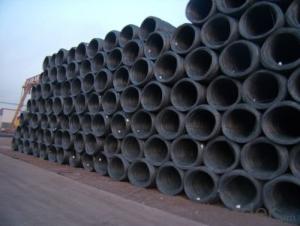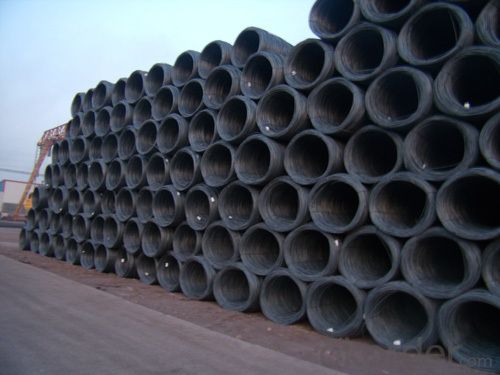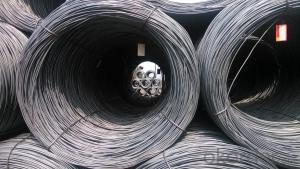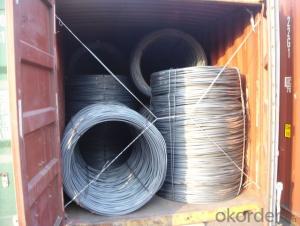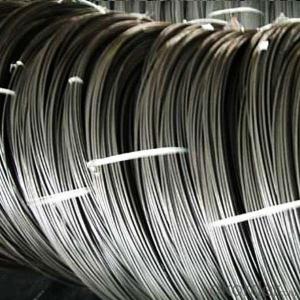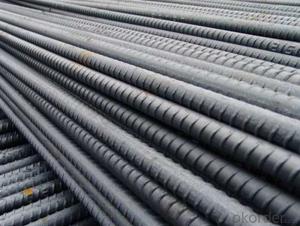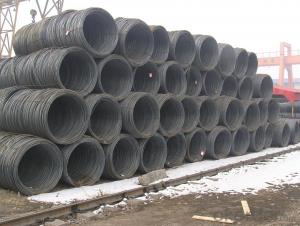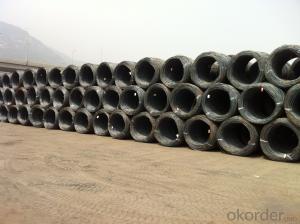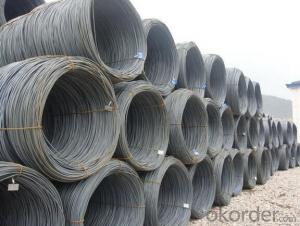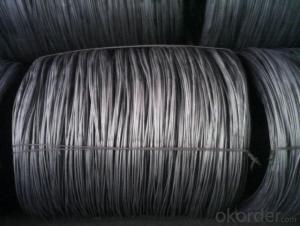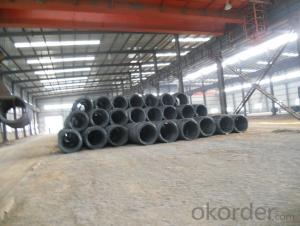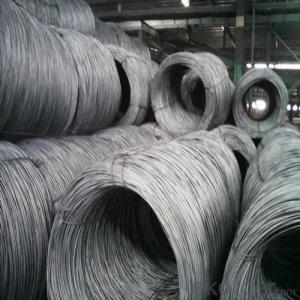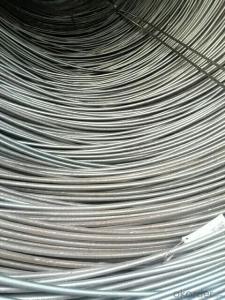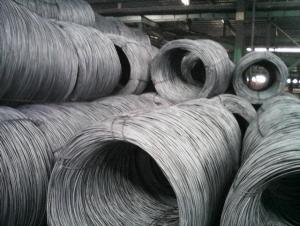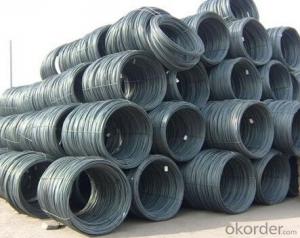Hot Rolled Mild Steel Wire Rod with Boron SAE1018
- Loading Port:
- China Main Port
- Payment Terms:
- TT OR LC
- Min Order Qty:
- -
- Supply Capability:
- -
OKorder Service Pledge
Quality Product, Order Online Tracking, Timely Delivery
OKorder Financial Service
Credit Rating, Credit Services, Credit Purchasing
You Might Also Like
Quick Details
Steel Grade:Q235,SAE1008,SAE1018
Standard:AISI, ASTM, BS, DIN, GB, JIS
Wire Gauge:5.5-14mm
Type:Drawn Wire
Application:Manufacturing
Alloy Or Not:Is Alloy
Model Number:5.5-14MM
Packaging & Delivery
| Packaging Details: | in bulk or as per customer's requirement |
|---|---|
| Delivery Detail: | 10-45 days after receipt of copy of L/C and advanced payment |
- Q: How is steel wire rod used in the manufacturing of wire forms for ski lifts?
- The manufacturing of wire forms for ski lifts heavily relies on steel wire rod, which is an indispensable component. These wire forms are responsible for delivering the required support and strength to the ski lift system. To begin with, steel wire rod is employed in the creation of primary cables that run alongside the ski lift structure. These cables bear the weight of both the ski lift and its passengers, guaranteeing their safety and stability. The ability of steel wire rod to withstand heavy loads and stress is of utmost importance in the functioning of the ski lift system. Furthermore, steel wire rod is also utilized in the production of suspension cables that connect the ski lift cabins to the primary cables. These suspension cables play a critical role in maintaining the balance and levelness of the cabins while in motion. The dependability and durability of steel wire rod ensure that these suspension cables can endure the constant movement and varying forces exerted on them. In addition, steel wire rod is also employed in the construction of safety cables, which serve as a precautionary measure. These safety cables act as a backup system, providing an extra layer of security for ski lift passengers. In the event of any unforeseen circumstances or malfunctions, the safety cables ensure that the cabins remain firmly attached to the primary cables, preventing any potential accidents. Overall, steel wire rod acts as the backbone of wire forms for ski lifts, offering the necessary strength, stability, and safety required for their operation. The quality and durability of steel wire rod play a vital role in ensuring the reliability and longevity of ski lift systems, ultimately contributing to the safety and enjoyment of skiers and snowboarders.
- Q: How is steel wire rod used in the manufacturing of musical instrument strings?
- Steel wire rod is commonly used in the manufacturing of musical instrument strings as it provides excellent strength, durability, and flexibility. This raw material is drawn into thinner gauge wire strands, which are then wound or wrapped around a core material to create the desired string. The high tensile strength of steel wire rod ensures that the strings can withstand the tension and stress exerted during playing, while its flexibility allows for the production of different string gauges and tensions to suit various musical instruments. Overall, steel wire rod forms the foundation for creating reliable and high-quality musical instrument strings.
- Q: How is steel wire rod used in the manufacturing of wire for electrical heating cables?
- Steel wire rod is used in the manufacturing of wire for electrical heating cables as it serves as the base material for the wire. The steel wire rod is first drawn into the desired diameter and then coated with an insulating material, usually a thermoplastic or thermosetting polymer. This coated wire is then further processed and assembled with other components to form the electrical heating cable. The steel wire rod provides the necessary mechanical strength and stability to the wire, allowing it to withstand the high temperatures and electrical currents required for heating applications.
- Q: What are the different types of steel wire rod surface finishes after wire drawing?
- There are several types of steel wire rod surface finishes that can be achieved after wire drawing. These include bright finish, black finish, galvanized finish, and coated finish. The bright finish is achieved by polishing the wire rod, resulting in a shiny and smooth surface. The black finish is obtained through a process called annealing, which involves heating the wire rod to a high temperature and then cooling it slowly, resulting in a darkened surface. The galvanized finish is achieved by applying a layer of zinc coating to the wire rod, providing protection against corrosion. Lastly, the coated finish involves applying a layer of specialized coating, such as PVC or nylon, to the wire rod for specific applications or enhanced properties.
- Q: How is steel wire rod used in the manufacturing of suspension components for automobiles?
- Steel wire rod is commonly used in the manufacturing of suspension components for automobiles due to its high strength and durability. It is typically formed and shaped into various suspension parts such as coil springs, stabilizer bars, and control arms. These components play a crucial role in providing stability, support, and smooth handling to the vehicle. The steel wire rod's properties allow it to withstand heavy loads and absorb shocks, making it an ideal material for suspension systems in automobiles.
- Q: How is steel wire rod used in the manufacturing of wire rope assemblies for lifting equipment?
- Steel wire rod is used in the manufacturing of wire rope assemblies for lifting equipment as it serves as the primary material for constructing the individual wires that make up the rope. The steel wire rod is carefully selected for its high tensile strength and durability, ensuring the wire rope has the necessary strength and resilience to safely lift and support heavy loads. The wire rod is first drawn into the desired diameter and then twisted and braided together to form the wire rope, which is then further processed and assembled with fittings and hardware to create the complete wire rope assembly used in lifting equipment.
- Q: What are the common recycling methods for steel wire rod?
- The common recycling methods for steel wire rod include melting and remolding the wire rod into new steel products, such as bars or coils, and using it as raw material in the production of other steel products. Additionally, the wire rod can be shredded and processed to extract any remaining non-ferrous materials, such as copper or aluminum, for separate recycling.
- Q: What are the major trade associations and organizations in the steel wire rod industry?
- The steel wire rod industry comprises numerous significant trade associations and organizations. Among them are the following prominent ones: 1. American Wire Producers Association (AWPA): AWPA serves as a trade association that represents manufacturers of steel wire and wire products in North America. Its primary focus lies in promoting the industry's interests, offering technical expertise, and facilitating networking opportunities for its members. 2. International Wire & Machinery Association (IWMA): IWMA operates as a global trade association that brings together companies involved in wire and cable production and processing. It arranges industry events, provides market intelligence, and fosters collaboration and knowledge-sharing among its members. 3. Wire Association International (WAI): WAI functions as a non-profit organization dedicated to advancing, educating, and innovating the wire and cable industry. It offers educational resources, organizes technical conferences and exhibitions, and provides networking opportunities for professionals in the field. 4. European Steel Association (EUROFER): EUROFER represents the European steel industry, including manufacturers of wire rods. Its objective is to promote a competitive and sustainable steel industry in Europe. EUROFER advocates for its members' interests at the European Union level and offers industry-related information and services. 5. China Iron and Steel Association (CISA): CISA serves as a national trade association that represents the Chinese iron and steel industry, including wire rod producers. It plays a crucial role in policy advocacy, market research, and coordination among stakeholders in China's industry. These trade associations and organizations play a vital role in supporting the steel wire rod industry. They provide a platform for collaboration, knowledge-sharing, and addressing common challenges. Furthermore, they serve as valuable resources for industry professionals, offering technical expertise, market information, and networking opportunities.
- Q: How is steel wire rod used in the manufacturing of fishing hooks?
- Steel wire rod is commonly used in the manufacturing of fishing hooks due to its strength and durability. The wire rod is typically shaped and cut to form the hook's body, ensuring it can withstand the tension and pressure exerted when catching fish. Additionally, the steel wire rod provides the necessary rigidity and sharpness required for effective hooking and holding of fish, making it an essential component in fishing hook production.
- Q: What are the standard dimensional accuracy requirements for steel wire rod?
- The standard dimensional accuracy requirements for steel wire rod depend on the specific industry or application, as different industries may have their own set of standards and specifications. However, in general, steel wire rod is expected to meet certain dimensional tolerances, which typically include requirements for diameter, roundness, straightness, and surface quality. These tolerances ensure consistency and quality in the production and use of steel wire rod.
Send your message to us
Hot Rolled Mild Steel Wire Rod with Boron SAE1018
- Loading Port:
- China Main Port
- Payment Terms:
- TT OR LC
- Min Order Qty:
- -
- Supply Capability:
- -
OKorder Service Pledge
Quality Product, Order Online Tracking, Timely Delivery
OKorder Financial Service
Credit Rating, Credit Services, Credit Purchasing
Similar products
Hot products
Hot Searches
Related keywords
